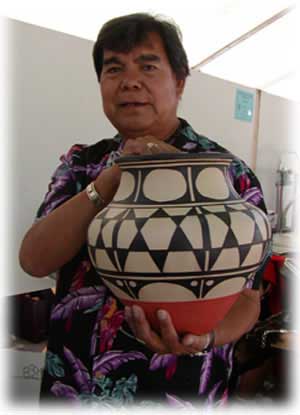 ClayHound Web
- Santo Domingo
Pottery
ClayHound Web
- Santo Domingo
PotteryReturn to:
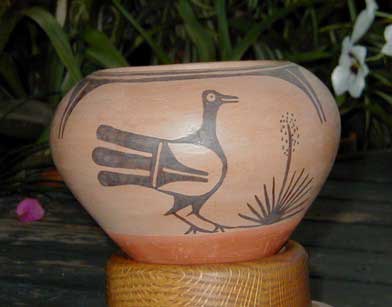 |
|
||||||||||||||
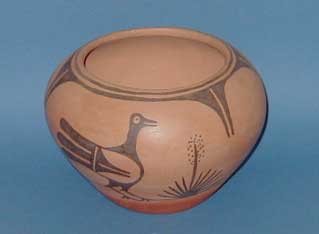 |
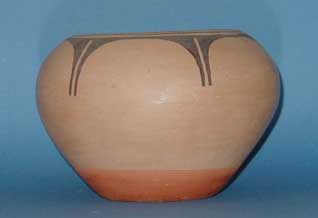 |
||||||||||||||
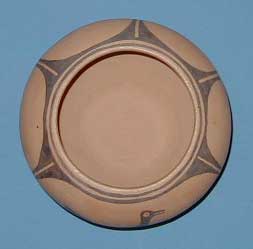 |
 |
||||||||||||||
|
|
|
||||||||||||||
|
|
|
||||||||||||||
|
Robert Tenorio is one of the
foremost pueblo potters. He wins ribbons regularly at Santa Fe Indian
Market and other prestigious competitions.
Robert began his career by
studying jewelry making. In 1968, he enrolled at the Institute of
American Indian Arts in Santa Fe. Learning to make jewelry "was the
popular thing then," he recalls, plus "I wanted to make jewelry to
help with the family." Robert, however, soon found himself next door
in the ceramics class, "stealing their clay and potting away" Long before the people of Santo Domingo Pueblo began making the exquisite stone, shell and silver jewelry for which they are now known, they were making pots. The potters of Santo Domingo delved for the red and white clay in secret places in the hills along the Rio Grande and deftly shaped clay and water into ollas and cooking bowls. Though he started his career by studying jewelry making, Santo Domingo native Robert Tenorio discovered that he couldn't keep his hands out of clay. As a result, he became one of a handful of Santa Domingo artists who have stimulated the revival of the ancient art of pottery making at the pueblo. In 1968, he enrolled at the Institute of American Indian Arts in Santa Fe to learn to make jewelry. "It was popular then, and I wanted to make jewelry to help with the family," says Tenorio. "Instead, I was always next door in the ceramics class, stealing their clay. Next thing, I'd be potting away." Tenorio made stew bowls for his mother, and when other women at the pueblo saw them, they wanted bowls, too. "My mother would constantly come to the school and ask me to make more bowls," he says. At that time, Tenorio made his bowls of stoneware, a type of processed clay that is fired in a kiln. Now he uses native clays and traditional firing methods like those used by his Pueblo Indian ancestors, creating polychrome jars, pots and canteens with the geometric classicism that characterized Santo Domingo ceramics for centuries In the Tenorio family, siblings Robert, Mary Edna Tenorio, Hilda Coriz and her recently deceased husband Arthur, and Paulita Pacheco are all potters (as well as Paulita’s son Andrew and Hilda’s daughter Ione). However, few other artists at Santo Domingo are making traditional pottery. "People tend to get into pottery once in a while and then forget about it the following week," Tenorio says. "They find out it’s too hard." His canteens, like the double one featured on the 1988 Santa Fe Indian Market poster, are a case in point. Like his other pots, coiling strands of clay from bottom to top makes this type. Then Tenorio smoothed the coils to create a smooth surface. Next comes the slip. Ten or twelve coats of a soupy mixture of clay and water are applied to the pot. Between each coat, Tenorio allows the pot to air dry, and then he polishes it to a satiny luster. The surface of the pot is very fragile during this stage; even a fingerprint left behind would show up after firing. To produce a black on red pot, Tenorio must combine white and red slips in the right proportions, then apply the mixed slip to the pot. The designs – geometric patterns and stylized images of birds, flowers and animals – then are painted on with a watery brown liquid made from the juice of the Rocky Mountain bee plant. "We boil the whole plant," Tenorio says. "We found that boiling almost any kind of plant will produce a black juice, but we use the bee plant because in the olden days it was our people’s food, and it's still present in our food. We call it wild spinach." The bee plant "paint" looks brown before firing, but in the fire the juice is carbonized. "That's the magic part that turns the paint black," Tenorio says, smiling. The paint won't work on red clay alone; the red slip must be mixed with white. "After firing, we put egg white on it [the pot], or grease, to bring out the sheen," Tenorio says. "It's something that our potters in the past did." His designs and shapes are traditional, a reflection of Tenorio's reverence for the past. "Some artists say they dream of designs and then get up and do them. For me, I'll save it until the next day, and when the time comes to start designing, it just disappears. But when I start to paint, it comes, all free-hand." Tenorio has won a string of awards at Indian Market, among them the Potcarrier Award for the Best Large Traditional Jar or Bowl in 1982, 1983 and 1984, and the Indian Arts Fund Award for Overall Excellence in a Traditional Craft, in 1988. His work is in museums, including the Museum of Mankind in London, and with private collectors all over the globe. He even gave a pot to Britain's Prince Phillip when Tenorio was in London. He says he doesn't know what the prince did with the pot, but he does like his creations to be useful. "Presently it’s for decorative purposes, but I'd rather see my pots being used, so I still make stew bowls and water jugs that you can actually use and wash. I try to keep my prices reasonable because I do not spend any money on materials. It comes from the earth and I have to share it. We ’re all striving for life, and pottery is bringing me and my family life. I feel I was put in this world to revive Santo Domingo pottery. And now that I've done that I feel good about it. I'm content. Everybody living will go, but my pots will stay here on this earth forever." (from: http://www.cristofs.com/Artist%20Bios/Pottery%20Bios/Robert%20Tenorio.html) |
|||||||||||||||
|
|
|||||||||||||||


